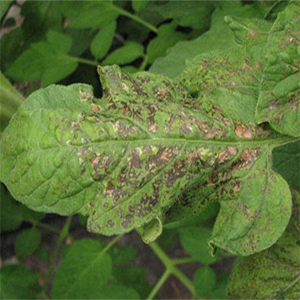There are a number of disease organisms known to attack poppies, including botrytis, downy mildew, and Pythium root rot. Early signs of these diseases can be detected with routine crop monitoring. To prevent the occurrence of these diseases, it is best to manage the environment by providing the proper plant spacing and adequate air movement, controlling the humidity, and providing proper irrigation practices.
Poppy Diseases
Rhizoctonia Root Rot
Rhizoctonia root-rot fungus attacks poppies during midsummer, entering their root systems and sometimes progressing into their stems. Dry rot at the base of the stems is its signature symptom. The disease blackens and shrivels roots, destroying their firm texture and white tips. Heat-wilted infected plants don’t respond to watering. Rhizoctonia solani fungus survives in the soil. Because poppies don’t transplant well, moving them to an uncontaminated site isn’t an option. If you suspect Rhizoctonia in your poppy bed, drench the soil with quintozene fungicide before symptoms surface. Water during flowering tends to be harmful to poppies so keep them on the dry side. Poppies in containers that get a lot of rain at the end of May are the most susceptible to root based fungal attacks.
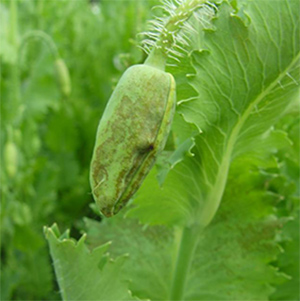

Downy Mildew
Reddish lesions on poppies’ upper leaf surfaces accompanied by fluffy gray, tan or purple areas on their undersides point to downy mildew (Plasmopara) infection. This airborne fungus thrives at 40 to 60 degrees Fahrenheit with humidity exceeding 90 percent. Its spores infect wet leaves within 12 hours of contact. Cultural control includes watering from beneath, spacing poppies for adequate air circulation and removing plant debris. Serious outbreaks demand fungicide.
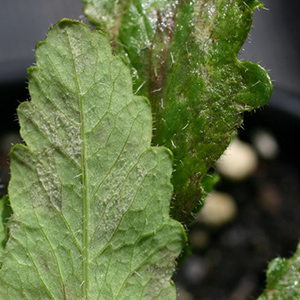

Powdery Mildew
Powdery mildew fungi target poppies growing in dry, shady spots. Their signature symptom is the white, powdery coating they leave on stems, leaves and blooms. The fungi flourish at temperatures between 60 and 80 degrees F. Bright light and temperatures of 95 F or higher destroy them. Protect poppies by giving them bright light and watering from above to wash spores from the leaves. Manage existing infections with horticultural oil like Neem sprayed on well-watered plants at a temperature below 90 F.
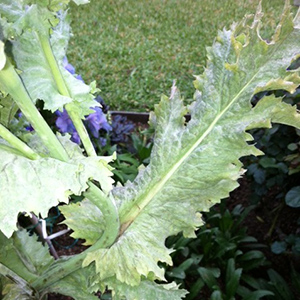

Pythium (Root Rot)
Pythium root rot occurs when soil moisture levels are excessively high and fungal spores present in the soil, come in contact with the susceptible plant. The base of stems discolors and shrinks, and leaves further up the stem wilt and die. Leaves near the base are affected first. The roots will turn black and rot or break. The best preventative is to use drip irrigation. At the very least, directly water onto the soil or mulch, and not on the plants themselves. As stated elsewhere excess water during flowering tends to be harmful to poppies so keep them on the dry side. Poppies in containers that get a lot of rain at the end of May are the most susceptible to root based fungal attacks.
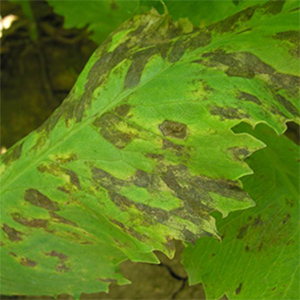

Grey Mold (Botrytis)
Grey mold (Botrytis cinerea) fungus disfigures damaged or older poppies during cool, wet weather. Brownish lesions on newly infected plants decay and develop masses of gray spores. Most active at temperatures between 69 and 77 degrees F, grey mold spores infect wet plants. Irrigate poppies from beneath early in the day to speed evaporation. Remove old or injured leaves and flowers. Captan, chlorothalonil and several other fungicides limit grey molds spread.
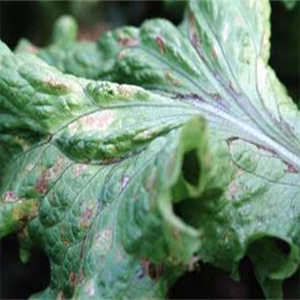

Tomato Spotted Wilt Virus
Incurable tomato spotted wilt disfigures poppies with stem streaking and dark-lined, spotted or ringed flower petals. The virus delays blooming and often distorts the blossoms. Thrips, tiny insects that feed within developing foliar and floral tissues, transmit the virus from infected to healthy plants. Blasting infested poppies with water from a hose dislodges small thrip populations. Spray poppies with narrow-range or neem oil when thrips first attack. Remove infected plants and avoid high-nitrogen fertilizers that stimulate thrip-attracting new growth.
